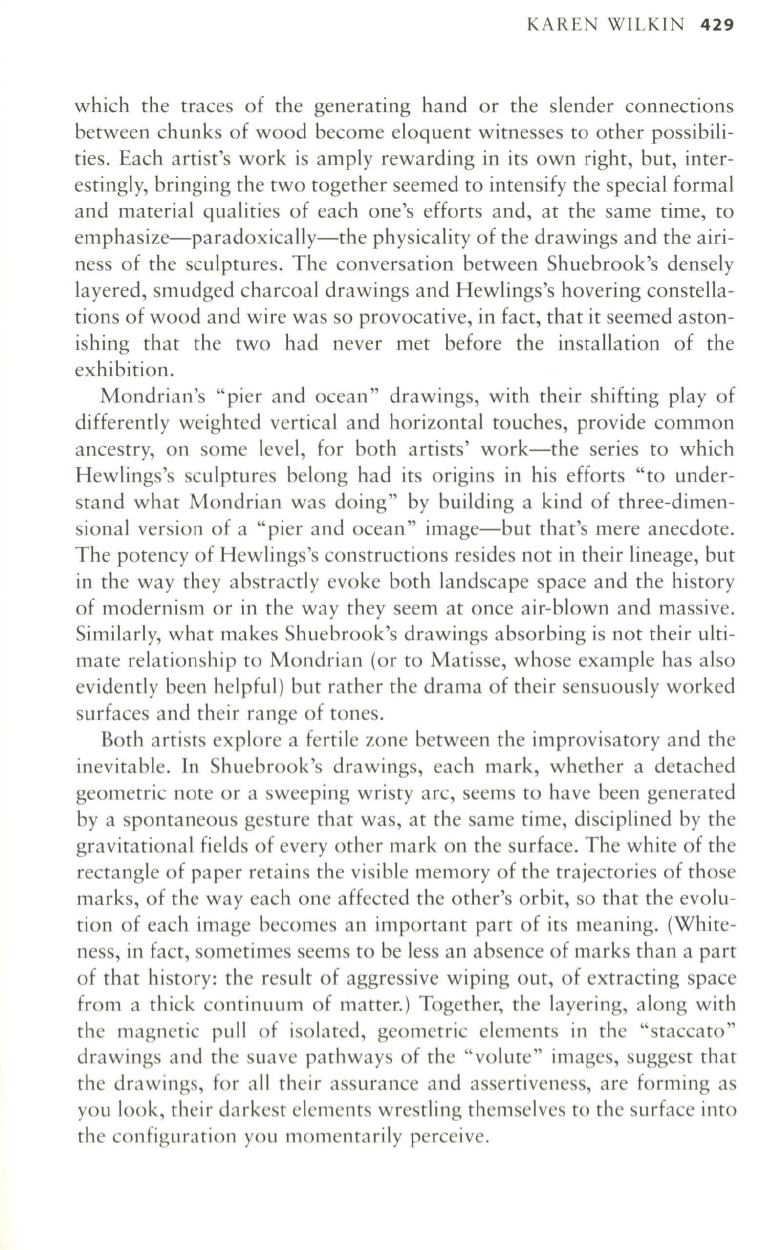
KAREN WILKIN
429
which the traces of the generating hand or the slender connections
between chunks of wood become eloquent witnesses to other possibili–
ties. Each artist's work is amply rewarding in its own right, but, inter–
estingly, bringing the two together seemed to intensify the special formal
and material qualities of each one's efforts and, at the same time, to
emphasize-paradoxically-the physicality of the drawings and the airi–
ness of the sculptures. The conversation between Shuebrook's densely
layered, smudged charcoal drawings and Hewlings's hovering constella–
tions of wood and wire was so provocative, in fact, that it seemed aston–
ishing that the two had never met before the installation of the
exhibition.
Mondrian's "pier and ocean" drawings, with their shifting play of
differently weighted vertical and horizontal touches, provide common
ancestry, on some level, for both artists' work-the series to which
Hewlings's sculptures belong had its origins in his efforts "to under–
stand what Mondrian was doing" by building a kind of three-dimen–
sional version of a "pier and ocean" image-but that's mere anecdote.
The potency of Hewlings's constructions resides not in their lineage, but
in the way they abstractly evoke both landscape space and the history
of modernism or in the way they seem at once air-blown and massive.
Similarly, what makes Shuebrook's drawings absorbing is not their ulti–
mate relationship to Mondrian (or to Matisse, whose example has also
evidently been helpful) but rather the drama of their sensuously worked
surfaces and their range of tones.
Both artists explore a fertile zone between the improvisatory and the
inevitable. In Shuebrook's drawings, each mark, whether a detached
geometric note or a sweeping wristy arc, seems to have been generated
by a spontaneous gesture that was, at the same time, disciplined by the
gravitational fields of every other mark on the surface. The white of the
rectangle of paper retains the visible memory of the trajectories of those
marks, of the way each one affected the other's orbit, so that the evolu–
tion of each image becomes an important part of its meaning. (White–
ness, in fact, sometimes seems to be less an absence of marks than a part
of that history: the result of aggressive wiping out, of extracting space
from a thick continuum of matter.) Together, the layering, along with
the magnetic pull of isolated, geometric elements in the "staccato"
drawings and the suave pathways of the "volute" images, suggest that
the drawings, for al l their assurance and assertiveness, are forming as
you look, their darkest elements wrestling themselves to the surface into
the configuration you momentarily perceive.


